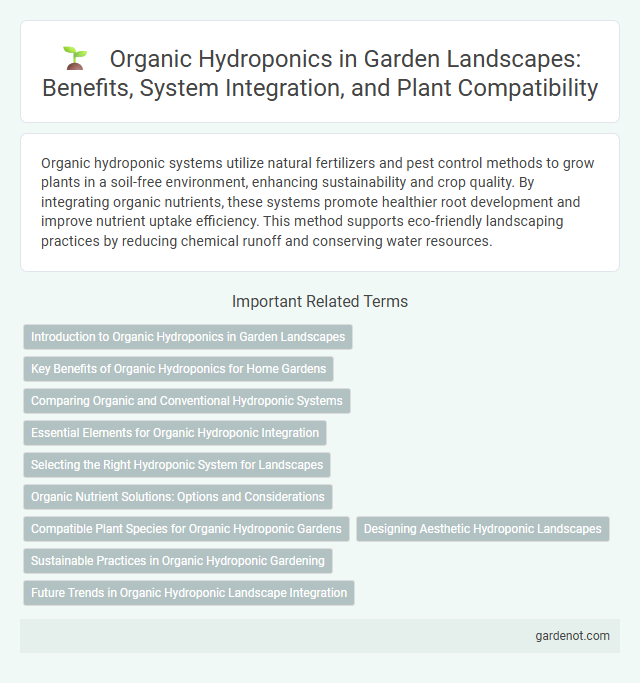Organic hydroponic systems utilize natural fertilizers and pest control methods to grow plants in a soil-free environment, enhancing sustainability and crop quality. By integrating organic nutrients, these systems promote healthier root development and improve nutrient uptake efficiency. This method supports eco-friendly landscaping practices by reducing chemical runoff and conserving water resources.
Introduction to Organic Hydroponics in Garden Landscapes
Organic hydroponics integrates natural fertilizers and biological pest control within soilless garden landscapes, promoting sustainable plant growth and healthier ecosystems. By using organic nutrient solutions derived from compost teas, fish emulsions, and seaweed extracts, this method enhances microbial activity and soil-like conditions in hydroponic systems. The approach reduces chemical inputs while improving plant nutrition, yield quality, and environmental impact in modern landscape gardening.
Key Benefits of Organic Hydroponics for Home Gardens
Organic hydroponics in home gardens enhances plant health by using natural nutrients and eliminates harmful chemical residues, promoting safer, pesticide-free produce. This sustainable method improves soil structure and microbial activity when combined with organic media, leading to increased nutrient availability and better plant growth. Water efficiency and reduced environmental impact are achieved through recirculation systems that conserve resources while supporting organic certification standards.
Comparing Organic and Conventional Hydroponic Systems
Organic hydroponic systems utilize natural nutrient sources such as compost teas and organic fertilizers, promoting microbial life and sustainable plant growth, while conventional hydroponics relies on synthetic nutrient solutions for precise nutrient delivery and faster growth rates. Organic methods often face challenges with nutrient availability and pest management but offer environmental benefits like reduced chemical runoff and enhanced soil health when integrated with soil-based systems. Conventional hydroponics excels in scalability and consistent yields, making it preferred for high-volume commercial production despite the environmental concerns associated with synthetic inputs.
Essential Elements for Organic Hydroponic Integration
Essential elements for organic hydroponic integration include a balanced nutrient solution derived from organic sources like compost teas, fish emulsions, and seaweed extracts, which provide vital macro and micronutrients. Maintaining optimal pH levels between 5.5 and 6.5 ensures nutrient availability and healthy root development. Incorporating beneficial microbes such as mycorrhizae and nitrogen-fixing bacteria enhances nutrient uptake and promotes a resilient hydroponic ecosystem.
Selecting the Right Hydroponic System for Landscapes
Selecting the right hydroponic system for organic landscapes involves evaluating factors such as crop type, space constraints, and nutrient delivery methods. Systems like nutrient film technique (NFT), deep water culture (DWC), and aeroponics offer distinct advantages for maximizing plant growth while maintaining organic standards. Prioritizing systems that enhance root oxygenation and facilitate efficient organic nutrient uptake ensures sustainable and thriving hydroponic landscapes.
Organic Nutrient Solutions: Options and Considerations
Organic nutrient solutions in hydroponic systems rely on natural ingredients like compost teas, worm castings, and fish emulsions to provide essential macro and micronutrients for plant growth. Selecting appropriate organic inputs requires consideration of nutrient availability, microbial activity, and system compatibility to ensure efficient nutrient uptake and avoid clogging. Balancing carbon-to-nitrogen ratios and maintaining proper pH are critical for maintaining nutrient stability and promoting healthy root development in organic hydroponic landscapes.
Compatible Plant Species for Organic Hydroponic Gardens
Organic hydroponic gardens thrive with plant species such as leafy greens like lettuce, spinach, and kale, which adapt well to nutrient-rich organic solutions. Herbs including basil, mint, and cilantro demonstrate robust growth and flavor profiles in organic systems, benefiting from natural nutrient cycles. Fruiting plants like tomatoes, peppers, and strawberries also perform successfully in organic hydroponic setups when provided with appropriate organic nutrient blends.
Designing Aesthetic Hydroponic Landscapes
Designing aesthetic hydroponic landscapes involves selecting organic nutrient solutions that promote healthy, vibrant plant growth while maintaining environmental sustainability. Incorporating diverse plant species with varying textures and colors enhances visual appeal, creating dynamic indoor or outdoor green spaces. Utilizing modular hydroponic systems allows for flexible arrangements, optimizing both functionality and artistic expression in organic hydroponic gardens.
Sustainable Practices in Organic Hydroponic Gardening
Sustainable practices in organic hydroponic gardening prioritize natural nutrient cycles by using organic fertilizers such as compost tea and fish emulsion, minimizing synthetic inputs. Maintaining biodiversity within the system promotes pest control and soil health through beneficial microorganisms and companion planting. Implementing water recycling and renewable energy sources further reduces environmental impact while enhancing resource efficiency in hydroponic landscapes.
Future Trends in Organic Hydroponic Landscape Integration
Future trends in organic hydroponic landscape integration emphasize sustainable nutrient sources like biofertilizers and compost teas, enhancing plant health and reducing reliance on synthetic chemicals. Innovations in sensor technology and AI-driven monitoring systems optimize organic nutrient delivery and environmental conditions, boosting crop yields and resource efficiency. Urban agriculture and vertical farming increasingly adopt organic hydroponics, promoting eco-friendly green spaces and local food production in densely populated areas.
Organic hydroponic Infographic

 gardenot.com
gardenot.com